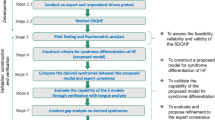Abstract
Objective
To explore the relationship between Chinese medicine (CM) constitutive susceptibility and syndrome diversity in diabetic nephropathy (DN).
Methods
Epidemiologic investigation on constitution adopting the “Constitution in Chinese Medicine Questionnaire” (CCMQ), and survey on syndrome type by CM syndrome scale (preliminary) were carried out in 180 DN patients. Cluster analysis on symptom items was used to determine the syndrome type, and canonical correlation analysis was used to analyze the relationship between patients’ constitution and syndrome.
Results
Baseline levels in all enrolled patients were not different statistically. Cluster analysis showed 8 syndromes existed in DN patients, namely: I, qi-yin deficiency with qistagnancy type; II, yin-yang deficiency with heat-water-blood stasis type; III, qi-yin deficiency with dampnessheat type; IV, yin-yang deficiency with blood-stasis and heat type; V, qi-yin deficiency with stagnant heat type; VI, yin-yang deficiency with inner dampness-heat stagnancy type; VII, yin deficiency with heat stagnancy type; and VIII, Kidney (Shen)-Spleen (Pi) deficiency with stagnant heat type. Correlation analysis on the 8 syndromes and the 9 constitutions showed statistical significant correlations between syndrome III and dampness-heat constitution (P=0.0001); syndrome IV and blood-stasis constitution (P=0.0001); and syndrome VII and yin-deficiency constitution (P=0.0180).
Conclusion
Certain relationship revealed between CM constitutions and syndrome types; constitution decides the disease genesis, its syndrome type and prognosis, as well as the change of syndromes.
Similar content being viewed by others
References
Meetoo D, McGovern P, Safadi R. An epidemiological overview of diabetes across the world. Br J Nurs 2007;16:1002–1007.
Yang WY, Lu JM, Weng JP, Jia WP, Ji LN, Xiao JZ, et al. Prevalence of diabetes among men and women in China. N Engl J Med 2010;362:1090–1101.
McDonald S, Excell L, Livingston B. Appendix II, in ANZDATA (Australia and New Zealand dialysis and transplant) registry report. Peritional Dial; 2008:499–518.
Yamagata K, Iseki K, Nittak K, Imai H, Iion Y, Matsuo S, et al. Chronic kidney disease perspectives in Japan and the importance of urinalysis screening. Clin Exp Nephrol 2008;12:1–8.
Lysaght M. Maintenance dialysis population dynamics: current trends and long term implications. J Am Soc Nephrol 2002;13:37–40.
Chinese Diabetes Society of Chinese Medical Association. China guideline for diabetes preventions and treatment. Chin J Prevent Control Chron Non-communic Dis (Chin) 2004;6:46–48.
Mogensen CE. Early diabetic renal involvelent and nephropathy. Amsterdam: Elsevier Science Publishers; 1987:306.
Wang Q, Zhu YB, Xue HS, Li S. Primary compiling of constitution in Chinese medicine questionnaire. Chin J Clin Rehabilit (Chin) 2006;10(3):20–22.
Zhu YB, Wang Q, Orikasa Q. Evaluation for reliability and validity of constitution in Chinese medicine questionnaire. Chin J Behav Med Sci (Chin) 2007;16:651.
Mou X, Zhou DY, Zhao JX. Exploration of the research method for Chinese medicine syndrome questionnaire of diabetic nephropathy. China J Tradit Chin Med Pharm (Chin) 2007;22:787.
Zhu YB, Wang Q, Xue HS, Orikasa Q. Preliminary assessment on performance of constitution in Chinese medicine questionnaire. Chin J Clin Rehabilit (Chin) 2006;10(3):15–17.
Wang Q. Three key problems in study of Chinese medicine constitution. J Tradit Chin Med (Chin) 2006;47:329.
Zhao Y, Tong XL, Chen L. Discussion on the relationship between evolvement of β cell function of type 2 diabetes and difference syndroms of TCM. Shandong J Tradit Chin Med (Chin) 2006;25(1):3–5.
Kuang DY. Several problems in study of constitution. J Beijing Univ Tradit Chin Med (Chin) 1986;9:18.
Jing H. Relationship between constitution and Chinese medicine syndrome. J Liaoning Coll Tradit Chin Med (Chin) 1992;6:18.
Song HP. Analysis on constitution and differentiation and treatment of Chinese medicine syndrome. Tradit Chin Med Res (Chin) 1998;11(4):11–14.
Chen JX. Significance of constitution in Chinese medicine diagnosis. Gansu Coll Tradit Chin Med (Chin) 1996;3(1):1.
Wang Q. Chinese medicine constitution. Beijing: China Medical Science Press; 1995:297.
Author information
Authors and Affiliations
Corresponding author
Additional information
Supported by the National Natural Science Foundation of China (No.30801467, No. 81273623) and the Natural Science Foundation of Zhejiang Province (No.Y2080683)
Rights and permissions
About this article
Cite this article
Mou, X., Zhou, Dy., Liu, Wh. et al. Study on the relationship between chinese medicine constitutive susceptibility and diversity of syndrome in diabetic nephropathy. Chin. J. Integr. Med. 19, 656–662 (2013). https://doi.org/10.1007/s11655-013-1411-0
Received:
Published:
Issue Date:
DOI: https://doi.org/10.1007/s11655-013-1411-0



